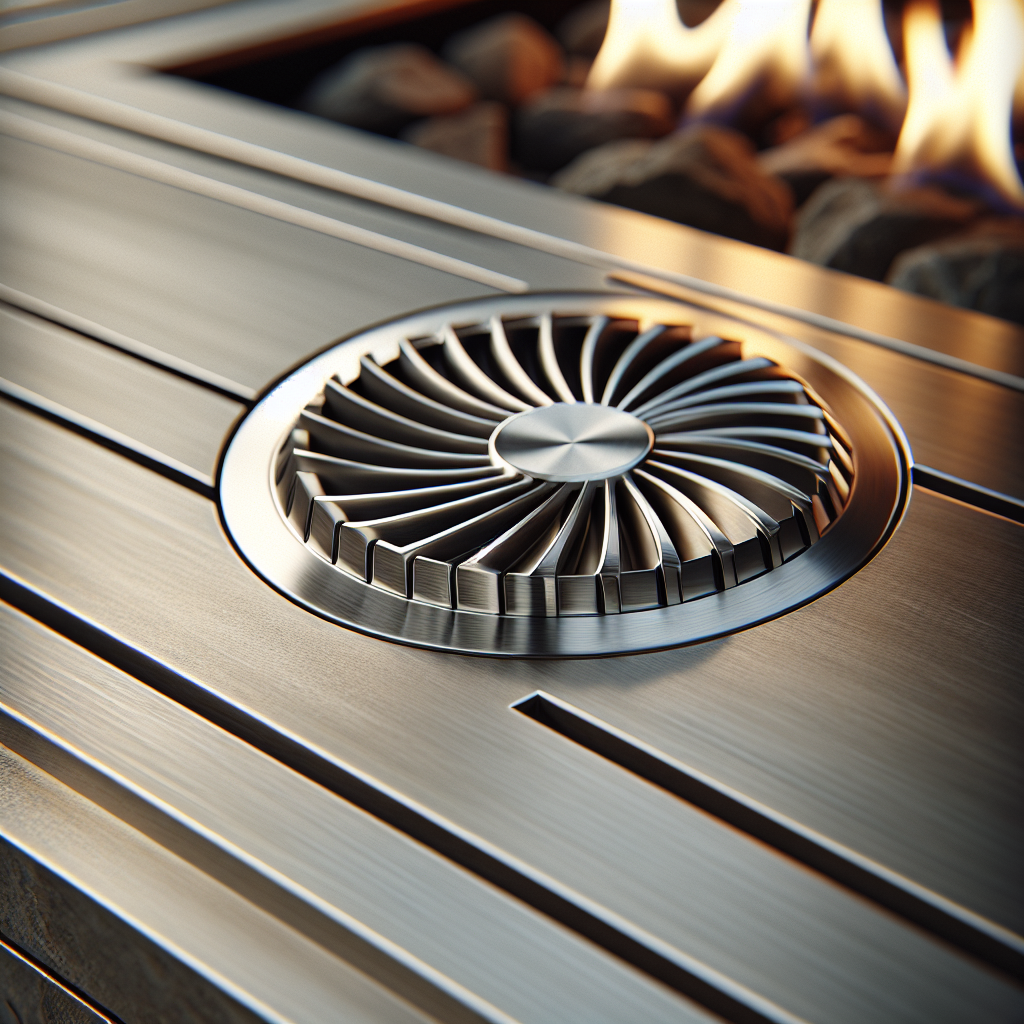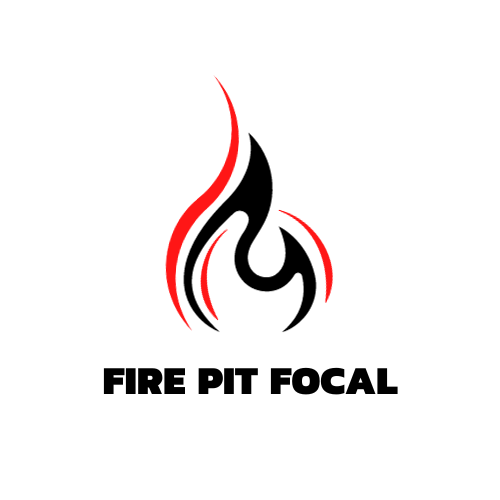If you own a gas fire table or are considering getting one, ensuring proper ventilation is key to enjoying it safely. Without adequate ventilation, the buildup of gas fumes can lead to potential health risks and even fire hazards. In this article, we will explore some simple yet effective ways to ensure proper ventilation for your gas fire table, so you can enjoy cozy nights around the fire without any worries.

Selecting the Location
Consider the Outdoor Space
When selecting the location for your gas fire table, it’s important to consider the layout and size of your outdoor space. Take into account the proximity of your fire table to other outdoor furniture and seating areas, ensuring that there is enough space for comfortable seating and movement. You want to create a cozy and inviting atmosphere, so make sure the fire table is easily accessible and a focal point in your outdoor living area.
Keep Distance from Flammable Objects
Safety should always be a top priority when using a gas fire table. It is crucial to keep a safe distance from flammable objects such as trees, bushes, and any outdoor structures. Ensure that there are no overhanging branches or nearby flammable materials that could potentially catch fire. Ideally, there should be a minimum clearance of at least 5 feet in all directions around the fire table to prevent accidental fires and ensure the safety of everyone enjoying the outdoor space.
Check for Local Regulations
Before installing your gas fire table, be sure to check for any local regulations or guidelines regarding outdoor fire features. Some areas may have specific rules regarding the use of fire tables, such as restrictions on the type of fuel used or the proximity to residential buildings. It is important to familiarize yourself with these regulations to ensure you are in compliance and to avoid any potential fines or legal issues.
Choosing the Gas Fire Table Design
Open or Closed Design
When selecting a gas fire table, you have the option to choose between an open or closed design. An open design allows for a more traditional fire pit experience, with a visible flame and the ability to roast marshmallows or enjoy the warmth of the fire. On the other hand, a closed design offers a sleek and modern look, with a glass or metal enclosure that surrounds the flame. Consider your personal preference and the overall aesthetic of your outdoor space when deciding between an open or closed design.
Built-in Ventilation Features
To ensure proper ventilation, it is important to choose a gas fire table that has built-in ventilation features. These features allow for the proper release of heat, smoke, and exhaust gases, facilitating the circulation of fresh air and minimizing the risk of carbon monoxide buildup. Look for fire tables that have strategically placed vents or chimneys to facilitate airflow and maintain a safe environment for you and your guests.
Maintaining Clearances
Minimum Clearance Requirements
Clearances refer to the amount of space required around the gas fire table to prevent any potential hazards. It is essential to adhere to the minimum clearance requirements specified by the manufacturer to ensure the safe operation of your fire table. These requirements typically include the distance between the fire table and any combustible materials, walls, or structures. By maintaining proper clearances, you reduce the risk of accidental fires and allow for adequate airflow around the fire table.
Avoiding Obstructions
When positioning your gas fire table, be mindful of any potential obstructions that may impede the airflow or pose a safety risk. Avoid placing the fire table near low-hanging branches, outdoor structures, or other objects that could restrict the movement of air. Additionally, ensure that there are no nearby combustible materials or debris that could potentially ignite due to the radiant heat emitted by the fire table. By avoiding obstructions, you allow for effective ventilation and minimize the potential for fire hazards.
Creating Adequate Airflow
Adequate airflow is crucial for proper ventilation and the safe operation of your gas fire table. To create optimal airflow, consider the placement of your fire table in relation to the prevailing wind direction. Positioning the fire table in such a way that it benefits from natural air currents will help facilitate the dispersal of smoke and exhaust gases. Additionally, you may also consider adding cooling fans or ventilation ducts to enhance air circulation and maintain a comfortable outdoor environment.
Appropriate Fuel Usage
Using the Recommended Fuel Type
Using the appropriate fuel type is essential for the safe and efficient operation of your gas fire table. It is important to follow the manufacturer’s recommendations and guidelines regarding the type of fuel to use. Most gas fire tables are designed to run on either natural gas or propane. Natural gas is a convenient and cost-effective option if you have access to a natural gas line in your outdoor space. Propane, on the other hand, offers flexibility as it does not require a fixed gas line and can be easily stored in a tank. Always use the recommended fuel type and avoid using alternative substances that can compromise the safety and performance of your fire table.
Avoiding Excessive Fuel Consumption
To ensure proper ventilation and avoid any potential safety hazards, it is crucial to avoid excessive fuel consumption when operating your gas fire table. As tempting as it may be to increase the flame size for a more dramatic effect, doing so can result in an inefficient burn and excessive smoke production. Follow the recommended fuel consumption rates provided by the manufacturer to maintain a balanced flame and minimize the release of harmful emissions. Remember, a well-maintained and properly fueled fire table not only ensures safety but also extends the lifespan of your appliance.
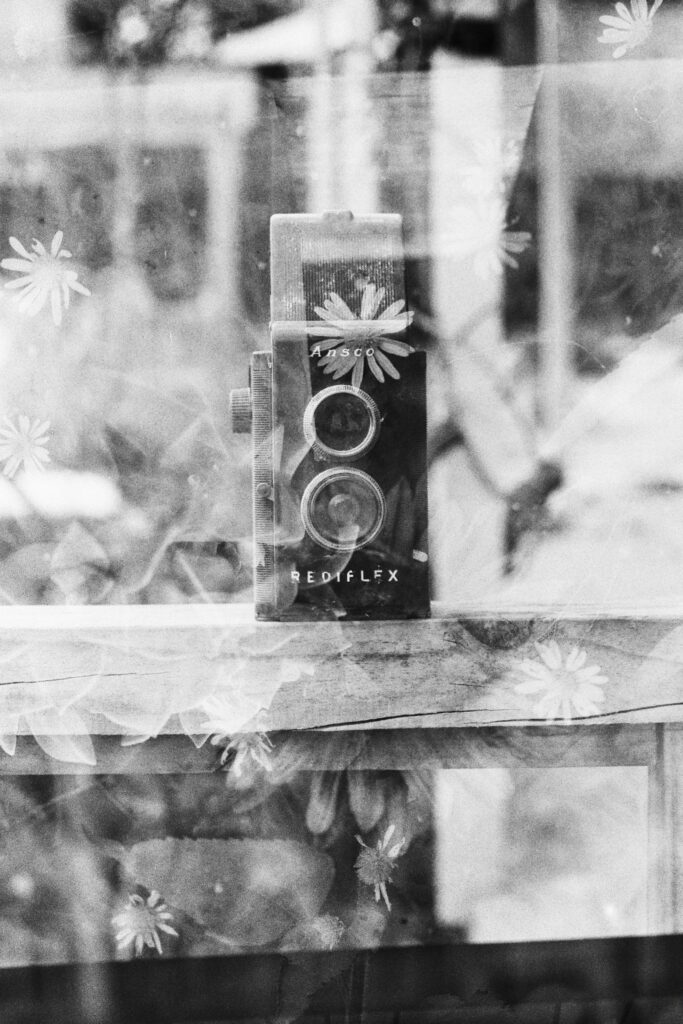
Regular Inspection and Maintenance
Inspecting Ventilation Openings
Regular inspection of your gas fire table’s ventilation openings is essential for maintaining proper airflow and ventilation. Over time, debris, dust, or insects may accumulate in these openings, obstructing the flow of air and preventing the efficient operation of the fire table. Inspect the vents and openings regularly and make sure they are clear of any blockages. Use a brush or compressed air to remove any debris and ensure unrestricted airflow for safe and optimal performance.
Cleaning and Removing Debris
Keeping your gas fire table clean and free from debris is vital to prevent any potential hazards and ensure proper ventilation. Regularly remove any leaves, twigs, or other debris that may have accumulated on or around the fire table. These combustible materials can increase the risk of fire and impede the flow of air. Additionally, wipe down the surfaces of the fire table to remove any dirt or residue that may affect the appearance or functionality of the unit. By maintaining a clean and debris-free fire table, you promote effective ventilation and enhance the overall safety of the appliance.
Periodic Professional Maintenance
While regular inspection and cleaning can go a long way in ensuring proper ventilation, it is also recommended to schedule periodic professional maintenance for your gas fire table. A qualified technician can perform a thorough inspection, checking for any potential issues or malfunctions. They can also clean the internal components of the fire table, ensuring that all ventilation pathways are clear and unobstructed. Professional maintenance not only helps to optimize the performance and lifespan of your fire table but also offers peace of mind knowing that your appliance is safe to use.
Ensuring Proper Air Circulation
Installing Ventilation Ducts
Installing ventilation ducts can significantly enhance the air circulation around your gas fire table. Ventilation ducts can be fitted to direct the flow of air, drawing in fresh air from outside and expelling smoke and exhaust gases safely away from the immediate vicinity of the fire table. These ducts provide a controlled and efficient means of ventilation, ensuring that the surrounding area remains clear of any harmful emissions. Consult with a professional to determine the appropriate type and placement of ventilation ducts for your specific outdoor space.
Utilizing Natural Air Currents
Utilizing natural air currents is an effective and environmentally friendly way to enhance ventilation around your gas fire table. By strategically positioning the fire table in an area where there is a natural breeze or wind, you can take advantage of the natural airflow to disperse smoke and exhaust gases. Observe the prevailing wind direction in your outdoor space and position the fire table accordingly to maximize the benefits of natural ventilation. This method not only ensures proper ventilation but also adds to the overall ambiance of your outdoor environment.
Adding Cooling Fans
Adding cooling fans to your gas fire table setup can further enhance air circulation and promote proper ventilation. These fans can be strategically placed to direct the airflow towards the fire table, facilitating the dispersal of smoke and exhaust gases. Cooling fans not only help maintain a comfortable outdoor environment by making the most of the available air currents but also assist in preventing the buildup of heat and reducing the risk of overheating. Consider investing in high-quality cooling fans that are specifically designed for outdoor use to ensure effective ventilation and optimal performance.
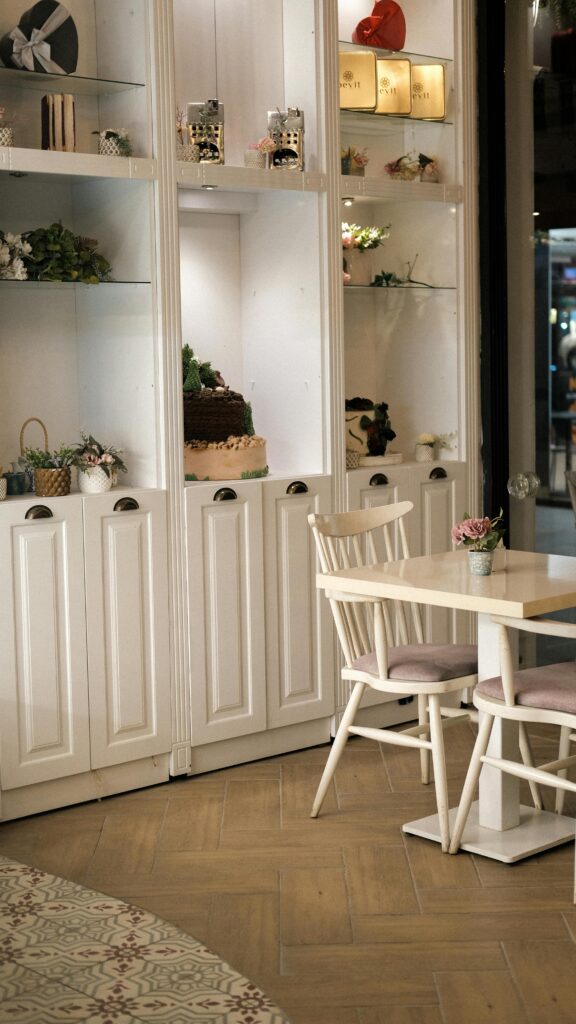
Monitoring Carbon Monoxide Levels
Installing a Carbon Monoxide Detector
Carbon monoxide is an odorless and colorless gas that can be emitted by gas fire tables, posing a serious health hazard if not properly ventilated. To ensure the safety of you and your loved ones, it is highly recommended to install a carbon monoxide detector near your gas fire table. This detector will alert you if the carbon monoxide levels exceed safe limits, giving you ample time to identify and address any ventilation issues. It is essential to regularly test and maintain the carbon monoxide detector to ensure its proper functioning and reliability.
Checking for Proper Ventilation
Regularly checking for proper ventilation is crucial in maintaining a safe environment when using a gas fire table. Observe the flame characteristics during operation – a clean and steady flame indicates that the ventilation is working effectively. If you notice a yellow or irregular flame, this could indicate a ventilation problem that needs to be addressed. Additionally, pay attention to any signs of smoke buildup or excessive heat around the fire table. Regularly assess the air quality and ensure that there is proper airflow to prevent the accumulation of carbon monoxide and other harmful gases.
Understanding Local Regulations
Familiarizing Yourself with Codes and Standards
To ensure that your gas fire table is installed and operated in compliance with local regulations, it is important to familiarize yourself with the applicable codes and standards. Different regions may have their own specific requirements regarding ventilation, clearances, and fuel usage. These regulations are in place to prioritize safety and prevent potential hazards. Take the time to research and understand the local regulations governing the use of gas fire tables in your area, and always ensure that your installation and operation are in full compliance.
Consulting with Local Authorities
Consulting with local authorities, such as your city’s zoning department, can provide valuable insights and guidance when it comes to proper ventilation for your gas fire table. Reach out to the relevant agencies or departments to inquire about any specific requirements or permits that may be necessary. Local authorities can provide you with the most up-to-date information and help answer any questions or concerns you may have. By seeking their expertise, you can ensure that your gas fire table is installed and operated safely and in accordance with local regulations.
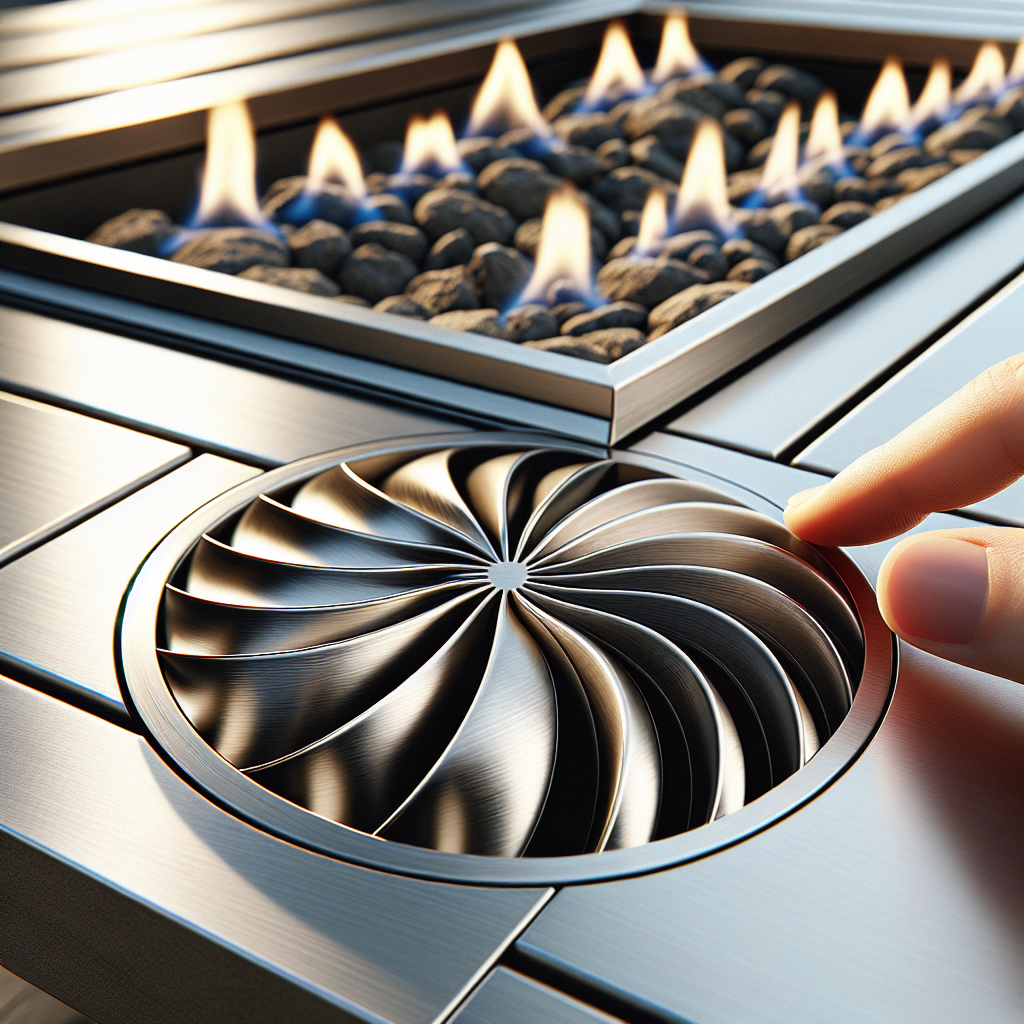
Safe Operating Practices
Monitoring Flame Characteristics
When operating your gas fire table, it is important to monitor the flame characteristics to ensure proper ventilation and safe operation. A clean and steady flame indicates that the air intake and ventilation are functioning effectively. On the other hand, a yellow or irregular flame may indicate a ventilation problem or improper fuel combustion. Additionally, monitor the size and intensity of the flame to prevent overheating and excessive fuel consumption. Regularly assess the flame characteristics and make any necessary adjustments to maintain a safe and enjoyable outdoor experience.
Keeping the Fire Table Clean
Regularly cleaning your gas fire table is not only important for aesthetics but also for maintaining proper ventilation. Over time, dust, dirt, and debris can accumulate on the surfaces and components of the fire table, obstructing ventilation pathways and impacting the overall performance. Clean the fire table regularly, following the manufacturer’s guidelines and using appropriate cleaning solutions. Focus on removing any residue or buildup from the ventilation openings, as well as wiping down the exterior surfaces. By keeping your fire table clean, you ensure optimal ventilation and extend its lifespan.
Properly Storing Fuel Containers
If you use propane for your gas fire table, it is important to practice safe storage and handling of fuel containers. Propane tanks should be stored in a well-ventilated area away from any potential sources of ignition. Ensure that the tanks are upright, secure, and not exposed to extreme temperatures. Regularly check for any signs of damage or leaks and promptly address any issues. It is also important to follow the recommended safety guidelines when connecting or disconnecting propane tanks from the fire table and to avoid any mishandling that could compromise the safety and functionality of your fire table.
Professional Installation and Assistance
Hiring a Licensed Gas Technician
To ensure proper ventilation and overall safety, it is highly recommended to hire a licensed gas technician for the installation of your gas fire table. A licensed technician has the expertise and knowledge to properly assess your outdoor space, install the fire table according to manufacturer specifications and local codes, and ensure that the ventilation requirements are met. They can also provide valuable advice on maintenance and safe operation. Investing in professional installation ensures that your gas fire table is set up correctly, reducing the risk of safety issues and ensuring optimal performance.
Seeking Expert Advice
If you have any questions or concerns regarding the ventilation of your gas fire table, seeking expert advice from professionals or knowledgeable individuals in the industry can provide valuable insights. Reach out to reputable retailers, manufacturers, or gas fireplace specialists who can offer guidance and answer any specific questions you may have. They can help explain the nuances of ventilation requirements and provide recommendations based on your unique circumstances. By seeking expert advice, you can make informed decisions and ensure that your gas fire table operates safely and efficiently.
